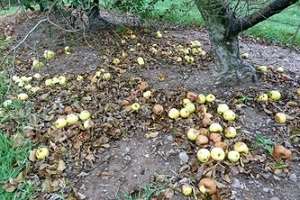Growers can get a jump on disease management for the 2017 season this fall. This month’s article will be a review of tips to manage apple scab, peach leaf curl, and cherry leaf spot.

The 2016 season is almost in our rearview mirror. Although the fruit harvest may be winding down, vigilance is still needed for managing tree fruit diseases, especially in preparation for 2017. No rest for the weary! The cooler weather is setting in and, before you know it, the leaves will be on the ground. Below is a review of what to have on your radar as you’re putting the 2016 season to bed, especially as the leaves are falling. In next month’s fruit times, the conversation will continue about what you need to be thinking about for 2017 disease management while pruning trees.
Apple scab: Leaf removal is key
This year started out to be a potentially bad scab year, thanks to the almost three week infection period we had during the peak spore dispersal period occurring late April - early May. Then the hot, dry weather during the summer shut scab down. An upside of hot, dry weather is that apple scab doesn’t like it and infection halts in its tracks. Infection is rare above 80 degrees, which may explain why our untreated blocks had lower incidence than usual of fruit scab this year, despite observing quite a bit on leaves earlier on. The lack of rain during the summer helped with minimizing spread of spores and potential infection, too.
If you noticed any scab in your orchard this season, you will definitely want to be proactive in mitigating problems for next year. Orchards are self-infecting when it comes to apple scab. Scab spores don’t travel very far, typically around 100 feet, and originate from old fallen leaves infected with scab on the orchard floor. Even if your fruit are clean of scab this season, there is still a possibility of leaves being infected. Reducing leaf litter and the scab spores they contain is an important defense strategy for any good scab management program.
To reduce the available inoculating spores for next season, growers are encouraged to spray trees with urea as close to leaf drop as possible. Spores need the leaf tissue in order to survive the winter and urea assists in the microbial breakdown of the tissue. Leaves with extra nitrogen stimulate the growth of these beneficial microbes. Using urea will reduce inoculum by 50 to 80% for the next season. Dissolve 40 pounds of feed grade urea in 100 gallons of water (5% solution), spraying 100 gallons per orchard acre. Feed grade urea is recommended due to the ease of dissolving it in water.
If you choose to not use urea, be sure your nitrogen comes from an ammonium source. Good coverage of the leaves is desired in order for leaves to absorb the urea. If the leaves have already fallen off of the tree, urea can also be sprayed to the fallen leaves on the orchard floor. Additional breakdown of the leaf tissue can be assisted by using a flail mower, which will chop up the leaves. Using urea and a flail mower can reduce scab spores for the next season by at least 90%. When there are no sources of scab on the orchard floor or within 100 feet, there is a very low risk of early scab infections.
Finally, late season urea application does not compromise cold hardiness and has shown to help with tree health and fruit set for the next season.
Cherry leaf spot: Leaf removal is key
Cherry leaf spot and apple scab are very similar when it comes to infection, fallen diseased leaves are the culprit for creating spring infections. I’ve seen many tart cherry trees already defoliated this season due to cherry leaf spot, which means there is already high inoculum pressure lurking on the orchard floor for next season. Like apple scab, sanitation is critical for effective management. Follow the same sanitation method for managing cherry leaf spot as you would for scab.
Peach leaf curl: Control needed when leaves have all fallen
In some areas where a fungicide spray to manage leaf curl wasn’t applied this year, I observed a very high incidence of the disease. During the season, leaf curl can cause defoliation, which can decrease tree growth and fruit production. Consequently, it is important to manage this disease and there is a narrow window for control, when all of the leaves have to be off of the trees (which will be pretty soon). Fungicide sprays do not control the disease when leaves are present since the leaves protect spores in hard-to-reach spaces.
Spores overwinter in bark crevices and around the buds. When the leaves have fallen from the trees the spores are exposed. Spray the trees with a fungicide, such as copper, lime sulfur, or chlorothalonil. If you aren’t able to apply your spray this fall, fungicides can be applied during late winter before bud break. As a result, you will reduce the chances of getting peach leaf curl in 2017.
Source: psu.edu